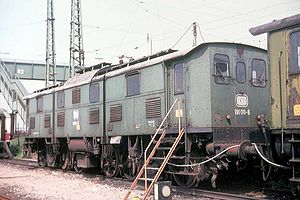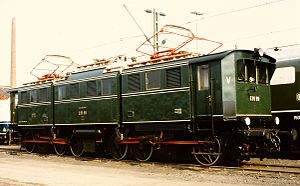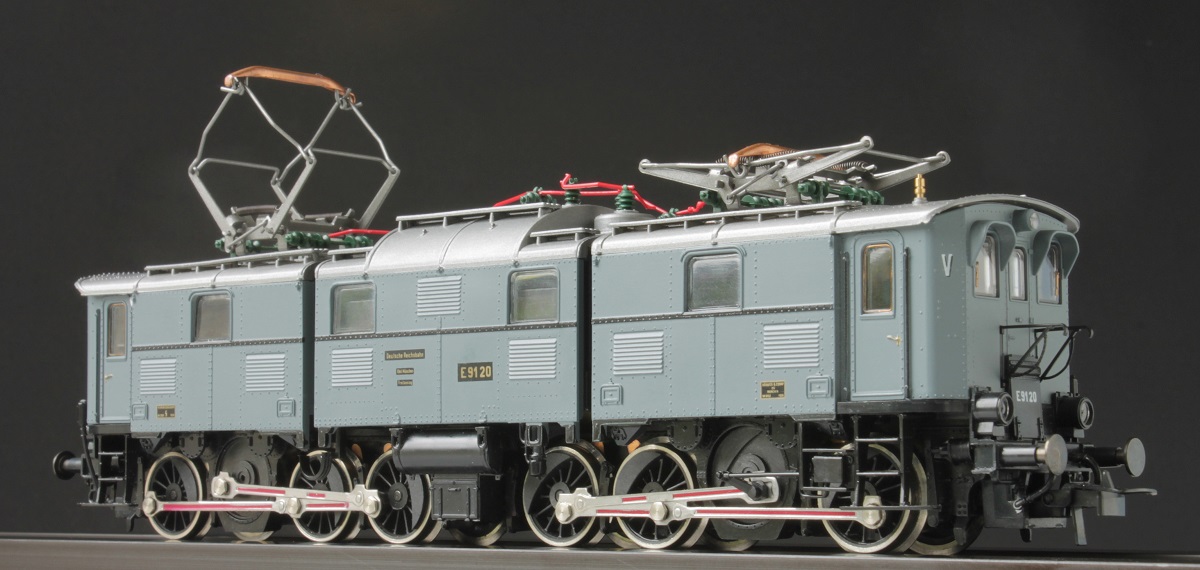DRG Class E 91
For Series E 91 included three different types of electric freight locomotives of the Deutsche Reichsbahn -Gesellschaft. In addition to the below two standard locomotive types, there was also a former Prussian type EC 538abc to EC 549abc that the series designation E was 91.3 in 1927.
- 2.1 history
- 2.2 External links
E 91.0 and E 91.8
History
Took place early in 1922 by the German Reichsbahn in its first procurement plan electrical unit locomotives, the order for 30 heavy freight electric locomotive wheel arrangement C'C 'for the mountain rescue. The system was supplied by Krauss ( mechanical part) and WASSEG ( electrical equipment) in the years 1925 and 1926. 16 locomotives were allocated to the Bavarian network. They received from the Bavarian Group Administration, the term EC 5 22501-516. The other 14 machines were used as EC 581 to EC 594 Wroclaw Breslau in Silesia network. In 1927 they received the car numbers E 91 01-16 ( Bavarian variant), or E 91 81-94 ( Prussian variant). In 1927, the supply of a further four locomotives that were still ordered with Bavarian farm numbers, but even with the new E 91 numbers 17-20 were delivered was.
The E 91 and E 77 series were similarly decorated. The three-axis drive racks of E 91 had an internal frame. In each case a double motor drive via a Winterthur - helical rod drive to the axles of an engine stand. The structure was threefold. The end portions each had a Endführerstand and a machine room and sat firmly on the drive racks. The middle part was placed on rotatable ball stud of the drive racks. The transitions between the different sections of the engine room were secured by bellows, diaphragms, there were none. The Bavarian locomotives could easily be of the Silesian distinguished by the additional front door between the two cab windows (see figure to the right of the Bavarian E 91 11, parked in the AW Frankfurt as a stationary transformer for the test field, and towards E 91.9 to recognize the underlying side vents ). The machine should be able to convey to 10 ‰ slope freight trains with 1200 tonnes of weight at 35 km / h and passenger trains of 500 tons weight with 45 km / h. As the locomotives were intended for freight and steep haul operations that did not require high speeds, the engine met the expectations set for them.
In the DR the southern German machines were always in Bavaria ( Bw München Hbf, Regensburg, Rosenheim and Freilassing ). The Silesian machines with which the extradition had begun in 1925, were located in Hirschberg depot. Of these, 1933 were implemented 91 E 89 to E 91 91 for the Bw Ulm Rbd Stuttgart. 1943, 91 E 88 and E 91 94 to Bavaria in 1944 also followed 91 E 82, 92 and 93
The remaining 91 E 83 to E 91 87 were transferred in the fall of 1945 in the Soviet zone of occupation. They arrived in 1946 as reparations to the USSR. Upon her return 1952/53, they stayed off. To restart the system for the Rübelandbahn was not seriously pursued because relatively soon, it was clear this route with 25 kV, 50 Hz to electrify. The locomotives were scrapped in 1962 and 1965 scrapped.
From the South German locomotives 1934 E, 91 05 and 1944 91 E 17 was retired. After further withdrawals from service remained from 1950, the 17 locomotives E 91 01-03, 07-11, 13, 15, 16, 18, 20, 81, 88, 89 and 94 in the stock of DB and have been modernized 1958-1960, where before all the electrical equipment was renewed. In this case also the cabs were changed ( removing the gateway device and window screens, third front windows added). With the introduction of computer -controlled operation the locomotives wore numbers from 1969, the series designation 191 and three-digit serial numbers. In recent years, the machines were located not only in the southern German railway depots, but with the Bw has Oberhausen in the Ruhr area. Because of their low top speed, they were mainly used for shunting. They were decommissioned 1969-1975.










